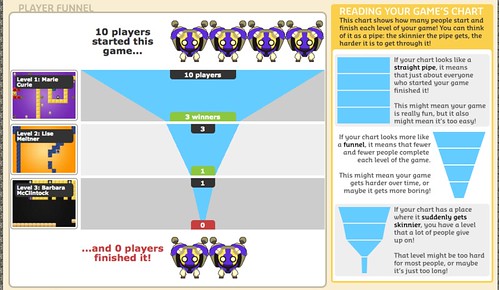
There are many things I like about Gamestar Mechanic as a site to teach game design. It’s easy to use, easy to publish and easy to connect young gamers into a gaming community. What I like best is how the games you play teach you about how to make your own games. One example is an activity that allows you to earn backgrounds and the games in the activity are all about colors that match and colors that clash, and how different tools might work with different backgrounds, and how others might not. It’s a really interesting activity, complete with a graphic novel story that underpins the work with a narrative.
When you get into the real design of your games, the site also provides you with an incredibly valuable tool known as the Funnel Chart. As people play your game, the chart shows you how players have progressed through the levels of your game idea. The visual will give the game designer clues as to levels that might have been too easy or too difficult, and how many players who started the game actually stayed with it until the end. Game designers use this knowledge, usually in beta mode, to engage in the iterative process of evaluation and improvement, making incremental tweaks to improve the gaming experience.
The Funnel Chart above is for a new game I created over the weekend as I was thinking of how we can bring a science theme into our game design. I went with a look at women in science. I’ll go into more depth around that game design another day, but I notice on the funnel chart that 10 people started my game but no one finished it. And only one person made it to the last level. I might need to make the first level a little easier so that players don’t get frustrated and give up. I want them to be challenged, but also, successful.
Without this kind of game play data, I would be sort of in the dark about what I created and about the experience of players. I know the game — I know how to play it in and out because I spent a lot of time designing and playing it myself. Understanding what others experience is an important element to make my game better. This is what I will be teaching my students as they develop their own games around a scientific theme in the coming month or two.
Peace (in the funnel),
Kevin
PS — I am going to try to share out the game. It seems like you can share outside of Gamestar for a short period of time, so the link may or may not be active when you view this.
Go to Women in Science game
I’m not very good at gaming, but I did try it, & can see how it would be fun & excellent critical thinking to design something like this, including content, for your students. I’m first going to send it to my grandson-a 10 year old gamer. I’ll share with my online tools group too. Thanks for explaining more!
Thanks for stopping by. I am not sure how long the game I designed will be embedded here (Gamestar has a time limit, I think) but I hope it helps your explanations.
Kevin